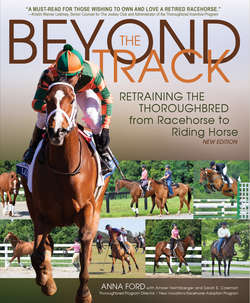Читать книгу Beyond the Track - Anna Morgan Ford - Страница 12
На сайте Литреса книга снята с продажи.
The Younger Years
ОглавлениеEven before conception, a Thoroughbred foal’s “life” involves a great deal of pedigree research to ensure that a competitive athlete is produced. Breeders accomplish this by studying race records and characteristics of different bloodlines, and then they consider affordability. With Thoroughbred stud fees ranging from $500 to $500,000, producing a foal can be a huge investment even before you consider veterinary fees, managing the broodmare before and after birth, and myriad other expenses to follow.
While people who breed riding horses may focus on producing offspring with good “minds” or outstanding movement, Thoroughbred breeders focus first and foremost on developing strong, fast offspring. The be-all and end-all goal is to have a competitive horse that can win. Of course, not all Thoroughbreds are winners, but one thing is certain—they all know how to run. Just watch a new crop of foals in the field sometime—at a very young age, they just naturally race each other. I remember one of the farriers at New Vocations in Marysville, Ohio, saying he could always pick out the horses destined for success as yearlings—they were always the fastest ones racing around the field. Future winners are the horses that refuse to be beaten, and this can be seen at a very early age, at play.
Thoroughbred racing is a huge, diverse industry with numerous participants at different levels. For example, within the breeding element exist large commercial breeding farms that may have over 100 broodmares. These farms breed with the specific purpose of selling stock at Thoroughbred sales, most commonly, yearling sales. Additionally, there are thousands of smaller, privately owned farms that breed horses with the intent to race them. Management varies, but in general, most breeding farms take excellent care of both mares and foals. With so much research and money invested in producing each animal, foals get the best of care so they can grow into strong and competitive individuals.
Some farms employ people who devote time each day to handling new foals and familiarizing them with human contact, beginning at birth. Other farms are limited as to how much time they have to spend with each baby. I find those that are handled at a young and impressionable age usually grow into more tractable adult horses.
One thing that most farms generally have in common is that multiple mares and foals are turned out together in large pastures so the foals become socialized with other horses their age. This allows them to run freely as they develop physically and mentally in a relaxed and natural setting. While indeed an idyllic start to life, all of these youngsters are headed toward the track—either via the sales ring or the farm’s own racing string.
